<<back
Lesson Plan LAO-PDR
D. Lao PDR
D.1. Water and environmentally sustainable development
D.1.1. Overview and background information:
- Topic:
- The important source of water in Lao PDR
- Background/context for particular lesson:
- The learners will know and understand of important source of water in Lao PDR, practice to plan on using and conserving the river, lake, and pond.
- The learning process will be filled by providing opportunities learners to analyze in current issues of situation of conservation of environmental sustainable development and how to make it more effective as a tool to add values of water conservation.
- Human values addressed
- Love
- Peace
- Right conduct
- Non-violence
- Truth
D.1.2. The Lesson Plan
Subject Matter area |
Science, Lao language and Arts |
Time duration |
Topic |
The important source of water in Lao PDR |
|
Grade |
8 |
|
Specific concepts covered in the lesson |
- Environmentally sustainable development related to water conservation
- Critical thinking skills
|
|
Lesson objectives |
By end of the lesson, learners should be able:
- To know and understand the source of water
- To tell the name of source of water in Lao
- To identify the river which flow into Ton kin gulf
- To know lakes, ponds in Lao PDR
- To explain underground water, hot spring water in Lao PDR
- To describe the benefit of rivers and the natural water sources in Lao PDR for human,
- To desribe human values for water conservation
|
|
Materials needed |
- Textbooks and teacher’s guide of social science grade 8
- Map of river of Laos
- Pictures related to the lesson
- song of Sai Nam
|
|
Teaching-Learning Steps: |
120 min |
Introductory or Motivational activities |
The teacher asks learners to sing the song of Sai Nam
Learners and teacher sing the song ‘Sai Nam’ in the class (Attachment 6.D.1.1) |
15 mins |
Lesson proper

|
Step 1: Question-answer
Ask the learners to read the content of lesson on the textbook above mentioned in materials about 5 minutes, and teacher then asks learners questions about Mekong River, such as:
- Where is the source of the Mekong River?
- How many countries does Mekong River flow through? Mention the names of the countries?
- From which part of Lao does the flow of Mekong River start and at which part of Laos is the end of the flow?
- How long is the Mekong River?
- Explain the characteristics of Mekong River?
- Describe the benefit of Mekong River for people in Lao?
- How do you conserve the river?
- Why do you need to conserve the river?
If learners’ answers are not sufficient, teacher needs to complete. |
15 mins |
|
Step 2:
- Divide the learners into small groups to have discussion:
- Group 1: Discuss direction of the river, why?
- Group 2: Discuss and list the name of the rivers in each province (from north to south)
- Group 3: Describe the benefit of Mekong River?
(teacher tells learner to use lesson materials, such as: map of river. See Attachment 6.D.1.2).
- Teacher asks the learners to write down the answers (results of discussion) on paper,
- Teacher asks a representative of each group to present the results into the class,
- Teacher facilitates learners to summarize
|
25 mins |
|
Step 3:
- Explain to learners by use of the map about rivers in Lao which flow to Vietnam
- Teacher asks learners to answer the following questions by use of the map about water:
- What are the names of rivers flowing to Vietnam Sea? In which province of Lao PDR is the river located?
If the learner answers are not sufficient teacher need to complete. |
15 mins |
|
Step 4:
Teacher asks learners by using following questions:
- In Lao PDR do we have lakes, ponds and natural sources? Are they wide or narrow?
If they are compared to the lake in Lao’s neighbour countriess, such as: Baikal, Tanganyika....
- In which part of Lao PDR are the Lakes located?
- What are the benefits we can get from lakes and ponds in Lao PDR?
|
15 mins |
|
Step 5: Question-answer
The teacher asks learners by using the following questions:
- Why wells are usually deep? Why are some of them shallow? Why do wells contain water resource?
- Teacher explains the importance of hot spring water:
(Hot water contains Sulfur)
- Teacher asks learners ways to conserve natural water resources?
The teacher summarizes about water resources and ways to conserve them |
15 mins |
Linkage with human values: |
- Helping their community to conserve rivers, ponds, and lakes.
- Self-control to protect rivers, lakes, and ponds.
- Avoiding to throw the garbage in rivers
- Conserving rivers to be a good people
- Understanding the benefits of rivers, lakes, and ponds.
|
|
Closure |
Homework
- Teacher asks learners to draw the map of rivers in Lao PDR (homework)
- Teacher remind learners to draw rivers in blue colour and the name of rivers in black colour
|
5 mins. |
Assessment / Evaluation |
Observation on:
- Learners’ participation to answer the questions
- Groups works, especially; Learners’ participation in the groups and Learners’ expression for their opinion.
- Cognitive test about learners’ knowledge
- Learners’ homework
- Maps drawn by learners
|
15 mins |
Attachment 6.D.1.1
A. Song of ‘The stream of water”
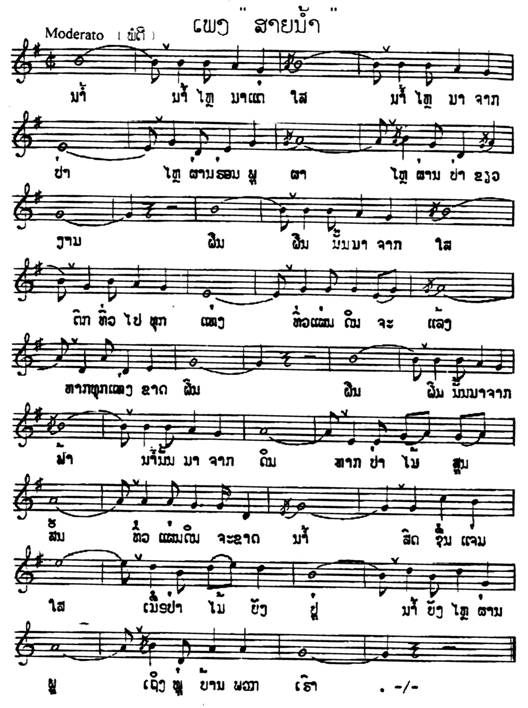

Attachment 6.D.1.2
Map of River in Lao PDR

Attachment 6.D.1.3
Assessment sheet
Name of teacher : _______________________________________
Grade/level : _______________________________________
School : _______________________________________
Subject Matter Area : Geography
Topic : The important source of water in Lao PDR
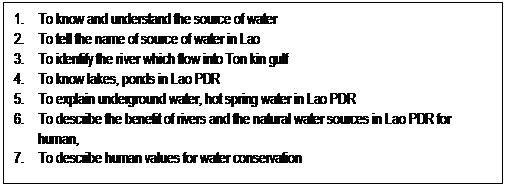
Assessment Procedures
What |
How |
Who (Assessor) |
Knowledge
- Sing a song of SAI NAM
- Know and understand the source of water and the meaning of song SAI NAM
|
Brainstorming |
Teacher-learners |
Scientific Inquiry Skills
- Identify the river which flow into Ton kin gulf
- Explain underground water, hot spring water in Lao PDR
Describe the importance of river and natural water source in Lao PDR, and advantages of river conservation, |
Learners work in group discussion |
Teacher |
Affective/Attitude Expression
Aware of importance of sufficient water resource and of conservation of water resource |
Learners work in group discussion |
Learners |
Values Expression
Learn the importance of sharing ideas with others abut the importance of water source in Lao PDR |
Learners work in group for a presentation |
Learners |
Personal Expression
Enjoy life and happiness in environmentally sustainable development which related to water conservation |
Observing learners’ participation in learning activities |
Teacher |
D.2. Water, human dignity and social equity
D.2.1. Overview and Background Information
- Background
- Learners’ pre-requisite knowledge in previous lesson.
- It is the fifth lesson of the subject on "World Around Us" for primary school grade one.
- Subject such as Languages, Mathematics, Moral Education, World around Us (including Geography, Health Education, Sciences)
- The learners will understand proper nutrition for healthy body.
- Teacher's notes
- Human, animals and plants need food, water, and sufficient nutrition for life
- Water exists in all living things (e.g. human, animals and plants)
- Water plays an essential role in life
- Learning goals/human values
- Love
- Peace
- Right conduct
- Non-violence
- Truth
D.2.2. The Lesson Plan
Subject Matter area |
World around Us |
Time duration |
Topic |
Food and Water |
|
Grade |
1 |
|
Specific concepts covered in the lesson |
- Food and water
- The sources of Nutritious food and water
- The importance of Nutritious food and water for human life
|
|
Lesson objectives |
By the end of the lesson, learners should be able:
- to identify the name of different types of foods and various sources of water
- to explain the importance of food and water for human life
|
|
Materials needed |
Pictures/poster (Attachments 6.D.2.1, 6.D.2.2, 6.D.2.3, and 6.D.2.4) |
|
Teaching-Learning Steps: |
45 min |
Introductory or Motivational activities |
Set Induction
- Teacher brainstorms with learners about different types of foods, e.g. rice, vegetables, meats and fruits.
- Teacher brainstorms with learners on water different sources, e.g. river, rainwater and hot spring.
|
8 mins |
Lesson proper
|
Step 1:
- Teacher divides learners into four groups to observe the posters/ pictures.
- Two groups observe posters/pictures about different types of food e.g. rice, meat vegetables, and fruits (Attachment 6.D.2.1).
- Two groups observe posters/pictures of various sources of water e.g. river, rainwater and hot spring (Attachment 6.D.2.2).
- Learners discuss questions given by teacher on:
- Which foods do learners like?
- Where does water come from?
|
12 mins |
Step 2:
- Learners present their ideas from their discussion voluntarily. (Learners can talk about anything pertaining to the posters/pictures which they observed).
- Teacher asks questions (Attachment 6.D.2.3):
- How many times do you have to eat in a day?
- How many glasses of water do you have to drink in a day?
- Why do we eat rice, fruits, meat and vegetables?
- Why do we have to drink water?
|
10 mins |
Linkage with human values: |
- Learners learn the importance of sufficient food and water in life, e.g. the importance of saving food and water
- Learners learn the importance of sharing food and water with others, e.g. generous, kind, love.
|
|
Closure |
Learners draw images on the worksheet accordingly (Attachment 6.D.2.4). |
10 mins. |
Assessment / Evaluation |
- Observation on the participation of learners in answering questions
- Complete the worksheet (Attachment 6.D.2.5).
|
5 mins. |
Attachment 6.D.2.1
Different Types of Food

Attachment 6.D.2.2
Various Sources of Water
A. Lake
B. Underground water
C. River
D. Rainwater

Attachment 6.D.2.3
How many times do you have to eat in a day?

Attachment 6.D.2.4
A. How do you feel

Attachment 6.D.2.5
B. Learners Assessment Sheet
Name of teacher : _______________________________________
Grade/level : _______________________________________
School : _______________________________________
Subject Matter Area : World Around us
Topic : Food and Water
Instructional Objective(s):
- to identify the name of different types of food and various sources of water
- to explain the importance of food and water for human life
- to talk about the importance of water and food
Assessment Procedures:
What |
How |
Who (Assessor) |
Knowledge
- Identify the name of different types of food and various source of water |
Brainstorming |
Teacher |
Scientific Inquiry Skills
- Explain the importance of food and water |
Learners work in group to observe the pictures |
Learners |
Affective/Attitude Expression
- Aware of importance of sufficient food and water |
Learners work in group discussion |
Teacher |
Values Expression
- Learn the importance of sharing food and water with others |
Learners work in group for a presentation |
Learners |
Personal Expression
- Enjoy life and happiness in food and water |
Observing learners’ participation in learning activities |
Teacher |
D.3. Water for health, sanitation, and recreation
D.3.1. Overview and Background Information
- Background/context for particular lesson
- This lesson used one hour for teaching (i.e. one hour per week). It is the fifth lesson of the subject on world around us for primary School grade 1
- The children will know and understand how to use the toilet correctly, practice to piss and to defecate correctly
- This lesson relates to the strand of water for health, sanitation and recreation.
- Learning goals/human values
- Love: cleanliness
- Right conduct: responsibility
- Truth: understanding on using the toilet
- Peace: share the knowledge with neighbors\others
- Non-violence: respect for other and their right privacy
- Effects of having sanitation and conserving water on hygiene
- Teacher's note
- Understanding and their practices on the use and he maintenance of the toilet.
D.3.2. The Lesson plan
Subject Matter area |
World around Us |
Time duration |
Topic |
The excretion |
|
Grade |
1 |
|
Specific concepts covered in the lesson |
- The right ways to keep body clean and healthy
- The right ways to defecate and piss
|
|
Lesson objectives |
By end of the lesson, learners should be able to:
- Understand how to use the toilet correctly
- Tell different kinds of toilet and the steps to use the toilet correctly
- Practice to piss and to defecate correctly
- Share knowledge with neighbours/others
|
|
Materials needed |
- Poster of latrine/toilet taken from a learner textbook
- Poster on using toilet
|
|
Teaching-Learning Steps: |
45 min |
Introductory or Motivational activities |
- Teacher shows the instructional purpose of the teaching and learning
- Teacher ask learners where they piss and defecate when they are at home?
|
5 mins |
Lesson proper
|
Step 1: question–answer
Teacher asks learners with following questions:
- What are the types of toilet in your school?
- Ask the learners to observe the pictures (Attachment 6.D.3.1, pictures A and B)
Step 2: Observe the pictures on (Attachments 6.D.3.1 and 6.D.3.2)
- What do learners see from the pictures?
- What types of toilet do you use at home? (Flush, water sealed, or pit latrine)
- What are the steps on using the toilet? (Attachment 6.D.3.2 , pictures A and B)
- After defecating why do you have to clean properly your vital organs from front to backside? (Attachment 6.D.3.2, Picture C)
Teacher Note: For protect the germs go inside the organ (reproductive organ especially for girls)
- Why should you use the toilet for pissing and defecating? (Attachment 6.D.3.2, pictures D and F)
Teacher Note: To avoid disease...
- Teacher asks the learners to observe on how to keep the toilet clean and healthy?
(Attachment 6.D.3.3 ,Pictures A, B, C and D)
- Teacher asks learners to describe the right ways to use the toilet!
|
25 mins |
Linkage with human values: |
- Awareness to keep water, hygiene, sanitation clean
- Understanding the reasons using toilet correctly
- Improving good behaviour related to water: saving water, protecting environment, being kind, love, and practicing.
|
|
Closure |
Learners can evaluate by themselves on using the toilet correctly to protect oneself against germs, and to save the water and to protect the environment |
5 mins. |
Assessment / Evaluation |
The teacher assesses the learners based on:
- Their participation in answering the questions
- Their understanding and their practices on the use and the maintenance of the toilet.
|
10 mins |
Assessment
The teacher assesses the learners based on:
1. Their participation in answering the questions.
2. Their understanding and their practices on the use and the maintenance of the toilet.
Attachment 6.D.3.1
Types of toilet
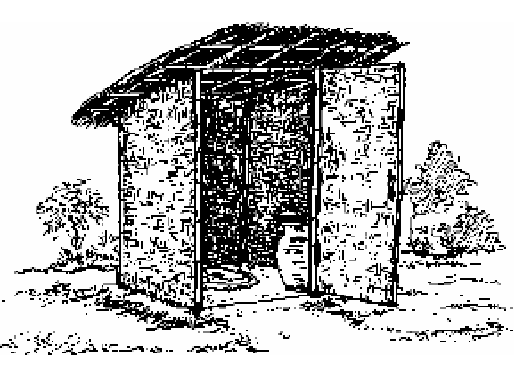
Picture A
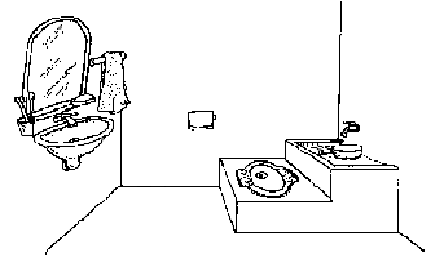
Picture B
Attachment 6.D.3.2
How to use toilet
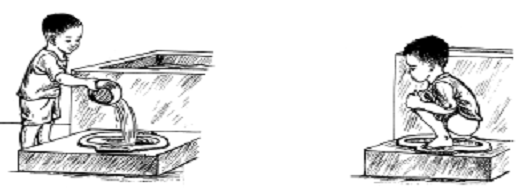
Picture A . Splash the toilet Picture B. Pissing / defecating
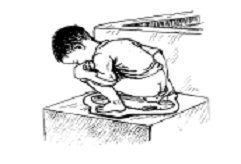
Picture C. Washing (from front to backside)
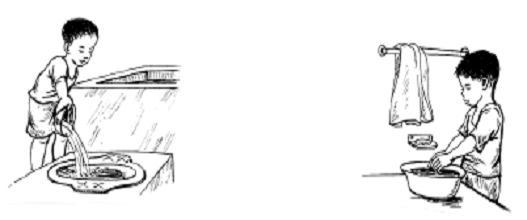
Picture D. Clean toilet after Picture F. Wash your
usage hands
Attachment 6.D.3.3
How to keep the toilet clean
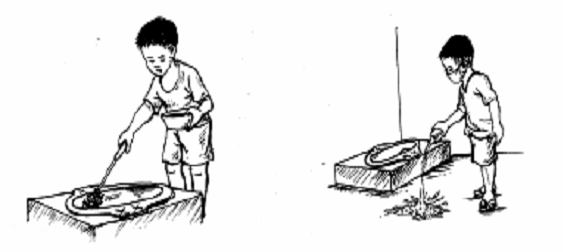
Picture A. Clean toilet as often Picture B. Wash toilet and
as possible floor using disinfectant
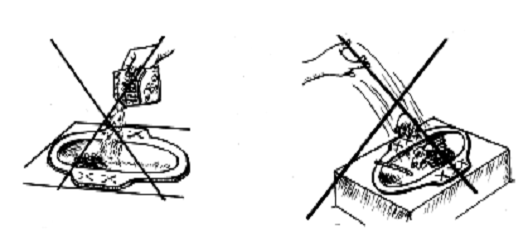
Picture C. Do not waste Picture D. Do not throw
detergent in toilet solid waste into toilet
D.4. Water in culture, traditions and religious practices
D.4.1. Overview and Background Information
- Title of the lesson
- Water in culture tradition and religious practice on saving and conserving water
- Background/context for particular lesson
- Learners pre-requisite knowledge in previous lesson
- It is the thirteenth lesson of the subject” Moral Education” for Primary school grade three.
- Subject consists of Language, World Around Us (including: Geography, Science, Healthy Education and Science)
- Learners will understand the benefit of the Pi May Lao
- Teacher's notes
- Culture, beliefs and tradition which are related to water conservation
- Critical thinking skills
- Enjoy life and happiness in Lao New Year
- Learning goals/human values
- Love
- Peace
- Right conduct
- Non-violence
- Truth
D.4.2. The Lesson Plan
Subject Matter area |
Art, science, Moral Education, Lao Language, Mathematics, Geography |
Time duration |
Topic |
Water in culture tradition religious practice on saving and conserving water |
|
Grade |
3 |
|
Specific concepts covered in the lesson |
- Manifestation of multiracial and multicultural unity in the society through posters
- Appreciation of harmony in the various culture tradition and religious practice
- Understanding of the” Lao New year”
|
|
Lesson objectives |
By the end of the lesson learners are able:
- To draw a poster regarding on the festival
- to manifest their ideas through the drawing
- to identify the benefits of the festival
- to create a slogan using their own drawing
|
|
Materials needed |
- Drawing materials (pencil, colours, draw board, drawing paper)
- Picture of the "Pee Mai Lao"
- Song of "Sa bai dee Pee May"
- Flower, perfume
- Plastic baskets, glasses, bowl
|
|
Teaching-Learning Procedures: |
(90 min) |
Introductory or Motivational activities |
- Teacher invites learners to sing a song “Sabaidy Pee May" (Attachment 6.D.4.1)
- Teacher brainstorms with learner on the different activities of Lao New Year
|
15 mins |
Lesson proper
|
Activity 1:
- Teacher tells learner the meaning of the Lao New Year Festival ("Pee Mai Lao")
- Teacher divides learners into four groups.
- Two groups draw a poster on using the water for Lao festival
- The other two groups write the slogan for saving water in the Lao New Festival
|
20 mins
20 mins.
20 mins. |
|
Activity 2:
Learners present their results:
- Their own drawing
- Explain the meaning of their slogan on “Lao New Year”
Activity 3:
- Learners get a chance to make a" Nam Hom " (i.e. fragrant water) (Attachment 6.D.4.1)
- Learners wish others by use of fragrant Nam Hom (Attachment 6.D.4.1)
|
Linkage with human values: |
- Learners understand important meaning of Lao New Year
- Awareness in the culture, beliefs and tradition of water Conservation.
- Learners enjoy life and happiness in Lao New year.
|
|
Closure |
Learners and teacher summarize and emphasize about:
- Cooperation among the people
- Respecting and loving other people
|
5 mins. |
Assessment / Evaluation |
- Observe learners’ performance
- Reflective drawing
|
10 mins |
Attachment 6.D.4.1
Materials
A. Song « Sabaidy Pee mai »
Sabaidy Sabaidy pee Mai
ko aui xay hai thuk thanh sokdy
thuksok lokphay yaa daimee
sotsian sivee talot pee mai eu
The meaning of the song:
Hello! Hello! New Year!
Wish you for all people good luck
Don’t have Poorest and sickness
It fresh and bright all the Pee Mai eu
B. Son pra (using the water to pour the Buda at the temple)
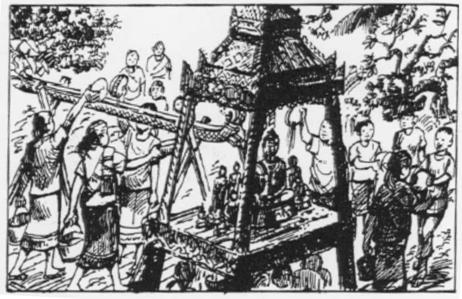
Attachment 6.D.4.2
Learners Assessment Sheet
Observation on the participation of learners in answering questions
Name of teacher : ____________________________________
Grade/level : ____________________________________
School : ____________________________________
Subject Matter Area : Geography
Topic : Water in culture tradition religious practice on saving and conserving water
Instructional Objective(s):
- To draw a poster regarding on the festival
- to manifest their ideas through the drawing
- to identify the benefits of the festival to create a slogan using their own drawing
Assessment Procedures:
What |
How |
Who |
Knowledge
The learners are able to
- Identify the meaning and benefit of festival "Lao New Year"
- Creative the festival slogan
|
|
Teacher |
Attitude Expression
- the learners express happy and enjoy in doing activity |
Group discussion |
Teacher |
Value expression
- their opinion about culture and tradition festival of water conservation |
Group discussion |
Teacher |
Personal expression |
Reflective drawing |
Teacher |
|
















